Physical Address
304 North Cardinal St.
Dorchester Center, MA 02124
Narrowing, or stenosis, of a cardiac valve can be due to a congenitally abnormal valve, a postinflammatory process (e.g., rheumatic), or age-related calcification. As the degree of valve opening decreases, the increasing obstruction to blood flow results in an increased flow velocity and pressure gradient across the valve. In isolated valve stenosis, clinical symptoms typically occur when the valve orifice is reduced to one quarter its normal size. In mixed stenosis and regurgitation, symptoms can occur when each lesion, if isolated, would be considered only moderate in severity.
Secondary changes in patients with valvular stenosis include the response of the specific cardiac chambers affected by pressure overload. The ventricular response to pressure overload is hypertrophy; the atrial response is dilation. Chronic pressure overload also can lead to irreversible changes in other upstream cardiac chambers and in the pulmonary vascular bed (e.g., in mitral stenosis).
Complete echocardiographic evaluation of the patient with valvular stenosis includes:
Imaging of the valve to define the cause of stenosis
Quantitation of stenosis severity
Evaluation of coexisting valvular lesions
Assessment of left ventricular (LV) systolic function
The response to chronic pressure overload of other upstream cardiac chambers and the pulmonary vascular bed
This echocardiographic evaluation then is integrated with pertinent clinical data for a complete evaluation of the patient.
The fluid dynamics of a stenotic valve are characterized by the formation of a laminar, high-velocity jet in the narrowed orifice. The flow profile in cross section at the origin of the jet is relatively blunt (or flat) and remains blunt as the jet reaches its narrowest cross-sectional area in the vena contracta, slightly downstream from the anatomic orifice ( Fig. 11.1 ). Thus, the narrowest cross-sectional area of flow (physiologic orifice area) is smaller than the anatomic orifice area. The magnitude of the difference between physiologic and anatomic area depends on orifice geometry and the Reynolds number (a descriptor of the inertial and shear stress properties of the fluid). The ratio of the physiologic to anatomic orifice area is known as the discharge coefficient .
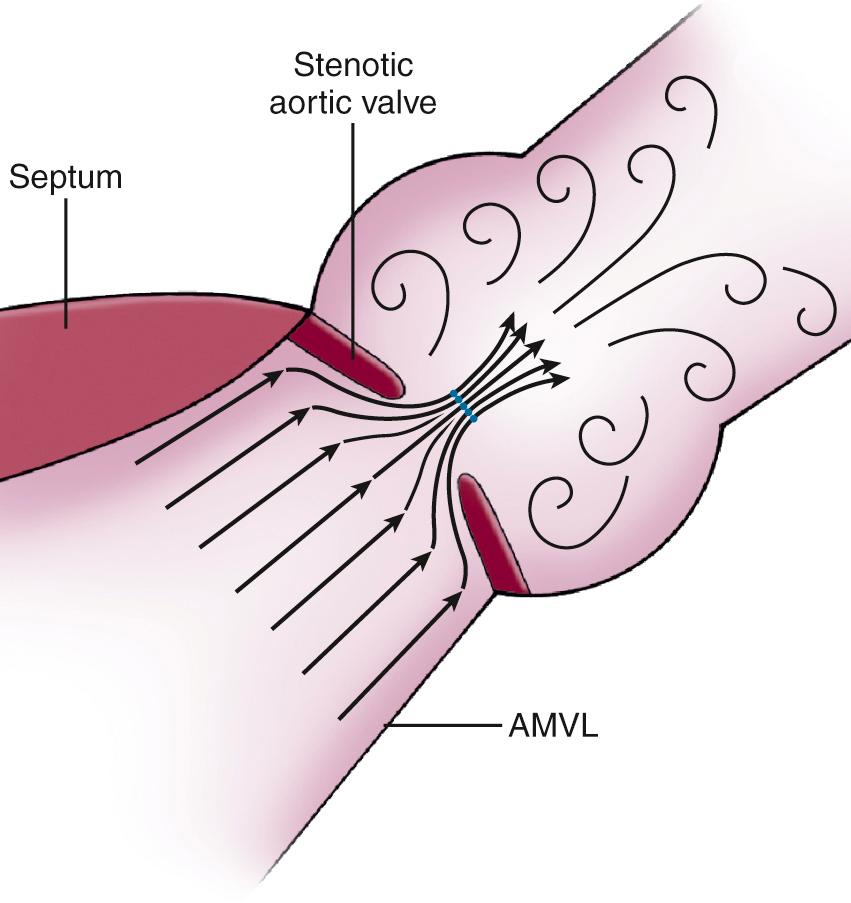
The length of the high-velocity jet also is dependent on orifice geometry and can be variable in the clinical setting with, for example, a very short jet across a deformed, irregular, calcified aortic valve and a longer jet across a smoothly tapering, symmetric, rheumatic mitral valve or a congenitally stenotic semilunar valve ( Fig. 11.2 ).
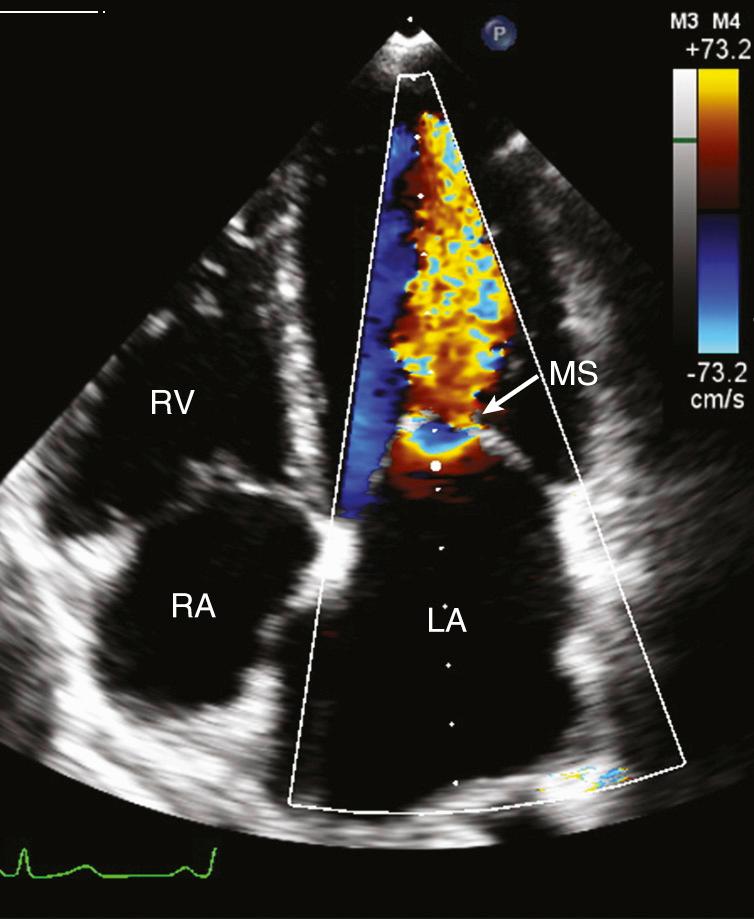
The pressure gradient across the stenotic valve is related to the velocity in the jet, according to the unsteady Bernoulli equation:
where Δ P is the pressure gradient across the stenosis (mmHg), ρ is the mass density of blood (1.06 × 10 3 kg/m 3 ), v 2 is velocity in the stenotic jet, v 1 is the velocity proximal to the stenosis, (dv/dt)dx is the time-varying velocity at each distance along the flowstream, and R is a constant describing the viscous losses for that fluid and orifice.
Historically, Daniel Bernoulli first described this equation in 1738 from studies of steady water flow in rigid tubes. The concepts were later expanded and refined by Euler. Of note, these equations may not be strictly applicable to pulsatile blood flow in compliant chambers and vessels, although clinical studies have shown that remarkably accurate pressure gradient predictions can be made with this approach. This equation was first applied to Doppler data by Holen in 1976 for stenotic mitral valves and by Hatle in 1979 for stenotic aortic valves.
By eliminating the terms for viscous losses and acceleration, substituting known values for the mass density of blood, and adding a conversion factor for measuring velocity in units of meters per second (m/s) and pressure gradient in millimeters of mercury (mmHg), the Bernoulli equation can be reduced to:
If the proximal velocity is less than 1 m/s, as is commonly the case for stenotic valves, it becomes even smaller when squared (e.g., [0.8] 2 = 0.64). Thus, the proximal velocity often can be ignored in the clinical setting so that:
This simplified Bernoulli equation allows highly accurate and reproducible calculation of maximum pressure gradients (from maximum velocity) and mean pressure gradients (by integrating the instantaneous pressure difference over the flow period).
Distal to the stenotic jet, the flowstream becomes disorganized, with multiple blood flow velocities and directions, although fully developed turbulence, as strictly defined in fluid dynamic terms, may not occur. The distance that this flow disturbance propagates downstream is related to stenosis severity. In addition, the presence of a downstream flow disturbance can be extremely useful in defining the exact anatomic site of obstruction, for example, allowing differentiation of subvalvular outflow obstruction (flow disturbance on the ventricular side of the valve) from valvular obstruction (flow disturbance only distal to the valve) ( Fig. 11.3 ).
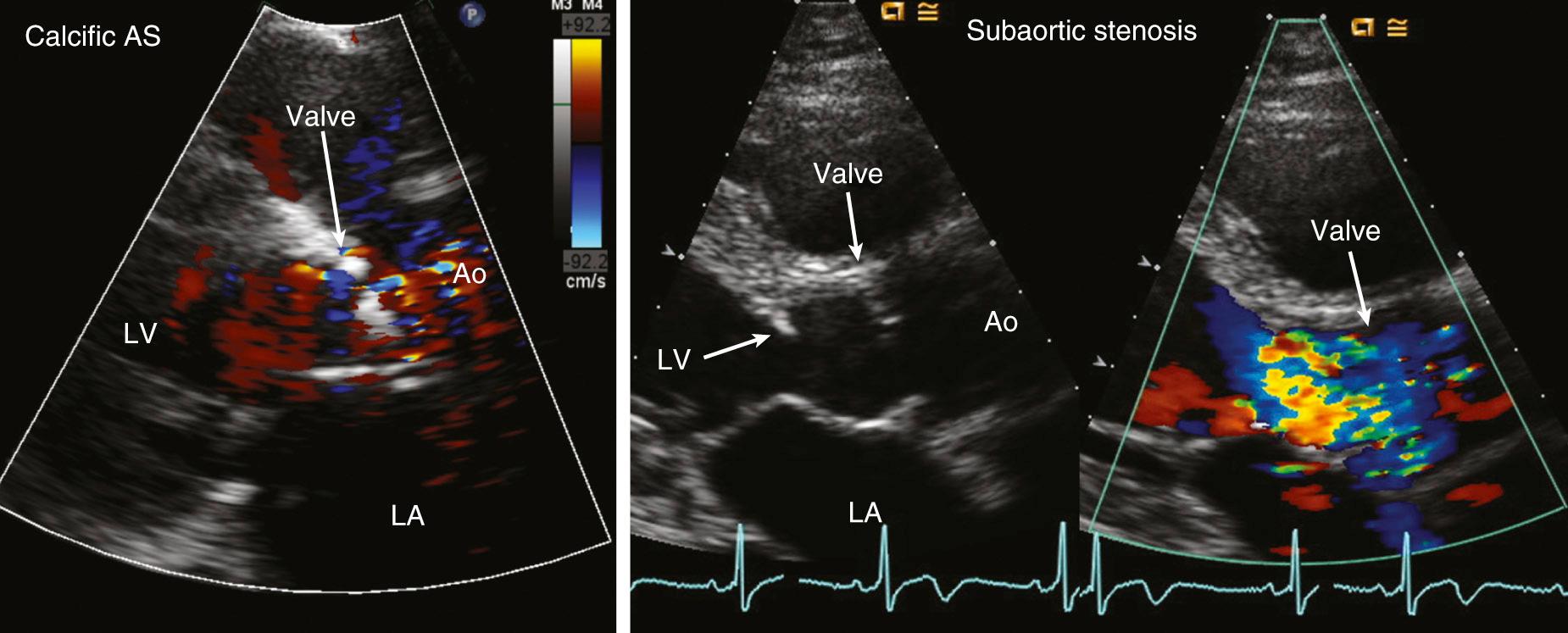
Proximal to a stenotic valve, flow is smooth and organized (laminar) with a normal flow velocity. The spatial flow velocity profile proximal to a stenotic valve depends on valve anatomy, inlet geometry, and the degree of flow acceleration. For example, in calcific aortic stenosis, the acceleration of blood flow by ventricular systole, coupled with a tapering outflow tract geometry, results in a relatively uniform flow velocity (a “flat” flow profile) across the outflow tract just proximal to the stenotic valve. Immediately adjacent to the valve orifice, acceleration occurs as flow converges to form the high-velocity jet, but this region of proximal acceleration is spatially small. The flow profile differs slightly for congenital aortic stenosis in that the proximal acceleration region under the domed leaflets in systole is larger than that of calcific stenosis. However, proximal flow patterns are similar regardless of disease etiology in that a relatively flat velocity profile is present at the aortic annulus.
In contrast, the flow pattern proximal to the stenotic mitral valve is quite different ( Fig. 11.4 ). Here, the left atrial (LA) to LV pressure gradient drives flow passively from the large inlet chamber (the LA) abruptly across the stenotic orifice. Proximal flow acceleration is prominent over a large region of the LA. The three-dimensional (3D) velocity profile is curved; that is, flow velocities are faster adjacent to and in the center of a line continuous with the jet direction through the narrowed orifice and slower at increasing radial distances from the valve orifice. The proximal velocity profile of an atrioventricular valve thus is hemielliptical, unlike the more flattened velocity profile proximal to a stenotic semilunar valve. Any 3D surface area proximal to a narrowed orifice at which all the blood velocities are equal can be referred to as a proximal isovelocity surface area (PISA).
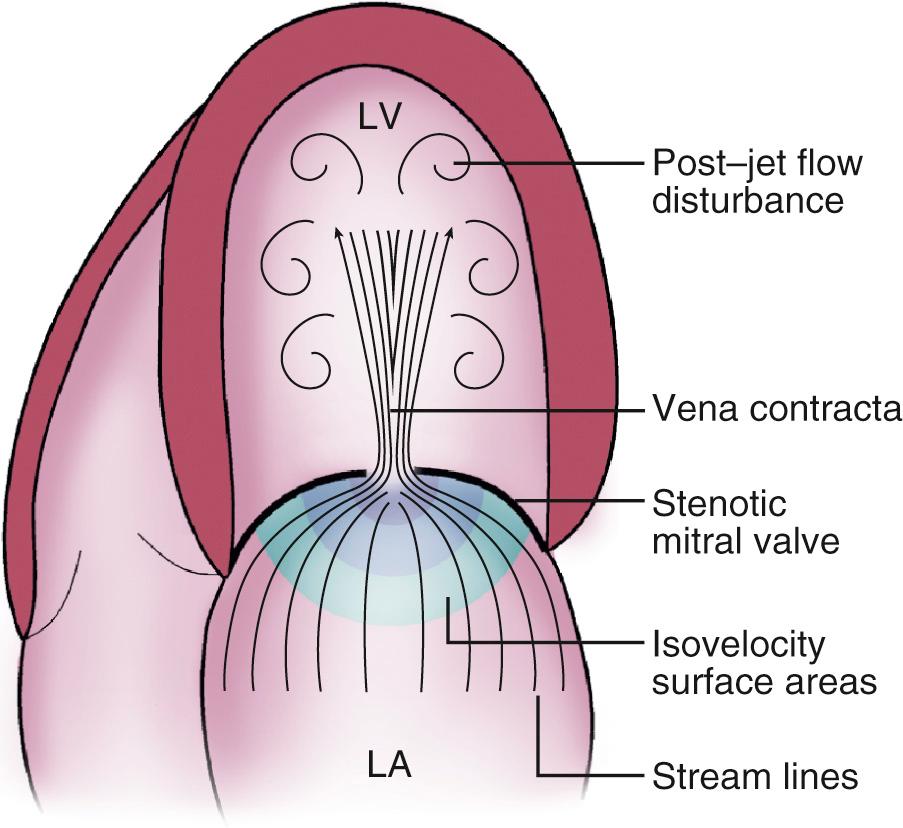
The clinical importance of these flow patterns is that stroke volume can be calculated proximally to a stenotic valve based on knowledge of the cross-sectional area of flow and the spatial mean flow velocity over the period of flow, as described in Chapter 6 . This concept applies to the flat flow profile proximal to a stenotic aortic valve (used in the continuity equation), to the proximal flow patterns seen in mitral stenosis, and to the proximal isovelocity surface areas seen with regurgitant lesions (see Chapter 12 ).
Aortic valve stenosis ( Fig. 11.5 ) in adults most often is due to:
Calcific stenosis of a trileaflet or congenital bicuspid valve
Congenital valve disease (bicuspid or unicuspid)
Rheumatic valve disease
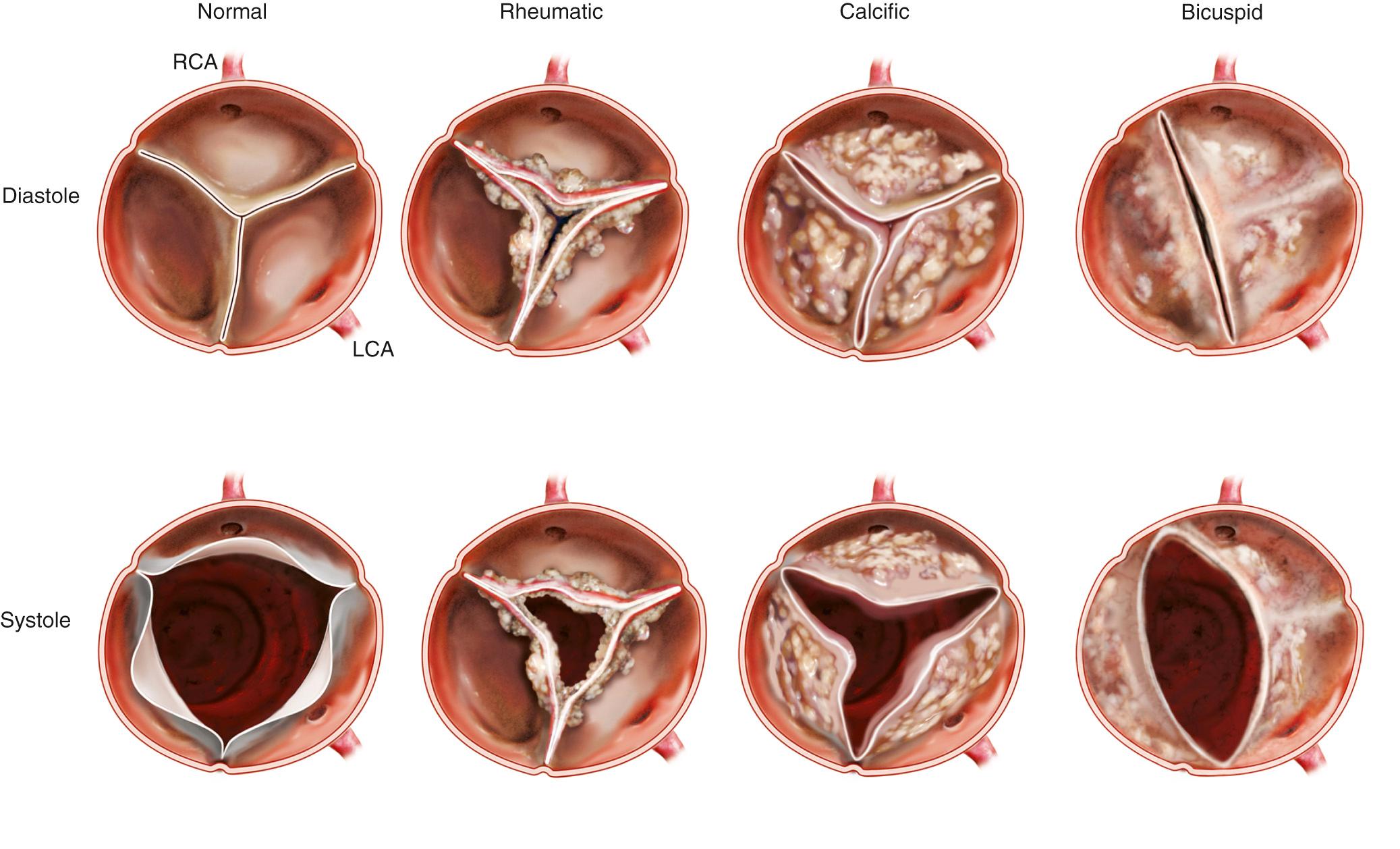
About 25% of all adults older than 65 years of age have aortic valve “sclerosis”—focal areas of increased echogenicity, typically at the base of the valve leaflets, without significant obstruction to LV outflow. About 10% to 15% of these patients have progressive leaflet thickening over several years that results in significant obstruction to LV outflow and typically manifests at 70 to 85 years of age. When obstruction is present, imaging shows a marked increase in echogenicity of the leaflets consistent with calcific disease and reduced systolic opening. Direct measurement of valve area on short-axis two-dimensional (2D) or 3D imaging is possible in some patients either with excellent transthoracic (TTE) images or from a transesophageal echocardiographic (TEE) approach. However, directly planimetered aortic valve areas should be interpreted with caution because of the complex anatomy of the orifice and calcific shadowing and reverberation, even with 3D imaging. It is critical to ensure that the narrowest orifice of the valve is visualized and nonplanar geometry is considered. Even when carefully performed, direct measurement of valve area on imaging reflects anatomic valve area, whereas Doppler data provide functional valve area ( Fig. 11.6 ).
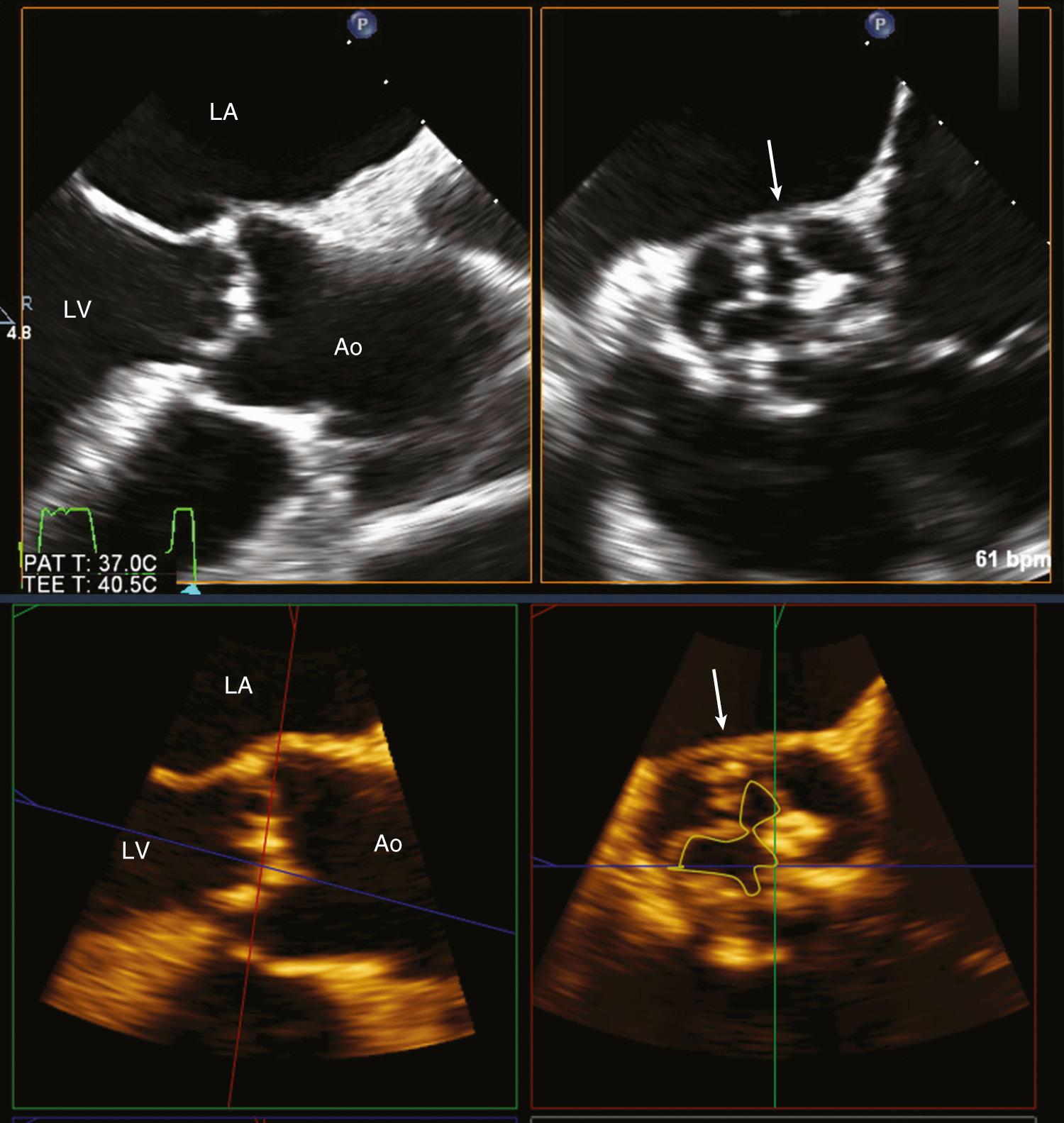
A congenital bicuspid valve accounts for two thirds of cases of severe aortic stenosis in adults younger than 70 years of age and one third of cases in those older than 70 years of age. Secondary calcification of a bicuspid aortic valve can be difficult to distinguish from calcification of a trileaflet valve once stenosis becomes severe; however, earlier in the disease course, a bicuspid valve can be identified on 2D parasternal short-axis views by demonstrating only two open leaflets in systole ( Fig. 11.7 ). Long-axis views show systolic bowing of the leaflets into the aorta, thus resulting in a “domelike” appearance. M-mode recordings may help in identifying a bicuspid valve if an eccentric closure line is present but can be misleading in terms of the degree of leaflet separation if the M-mode recording is taken through the base, rather than the tips, of the bowed leaflets. Similarly, planimetry of valve area may be erroneous if the image plane is not aligned with the narrowest point at the leaflet tips. The 3D imaging is helpful in the identification of bicuspid valve anatomy when the diagnosis is not clear.
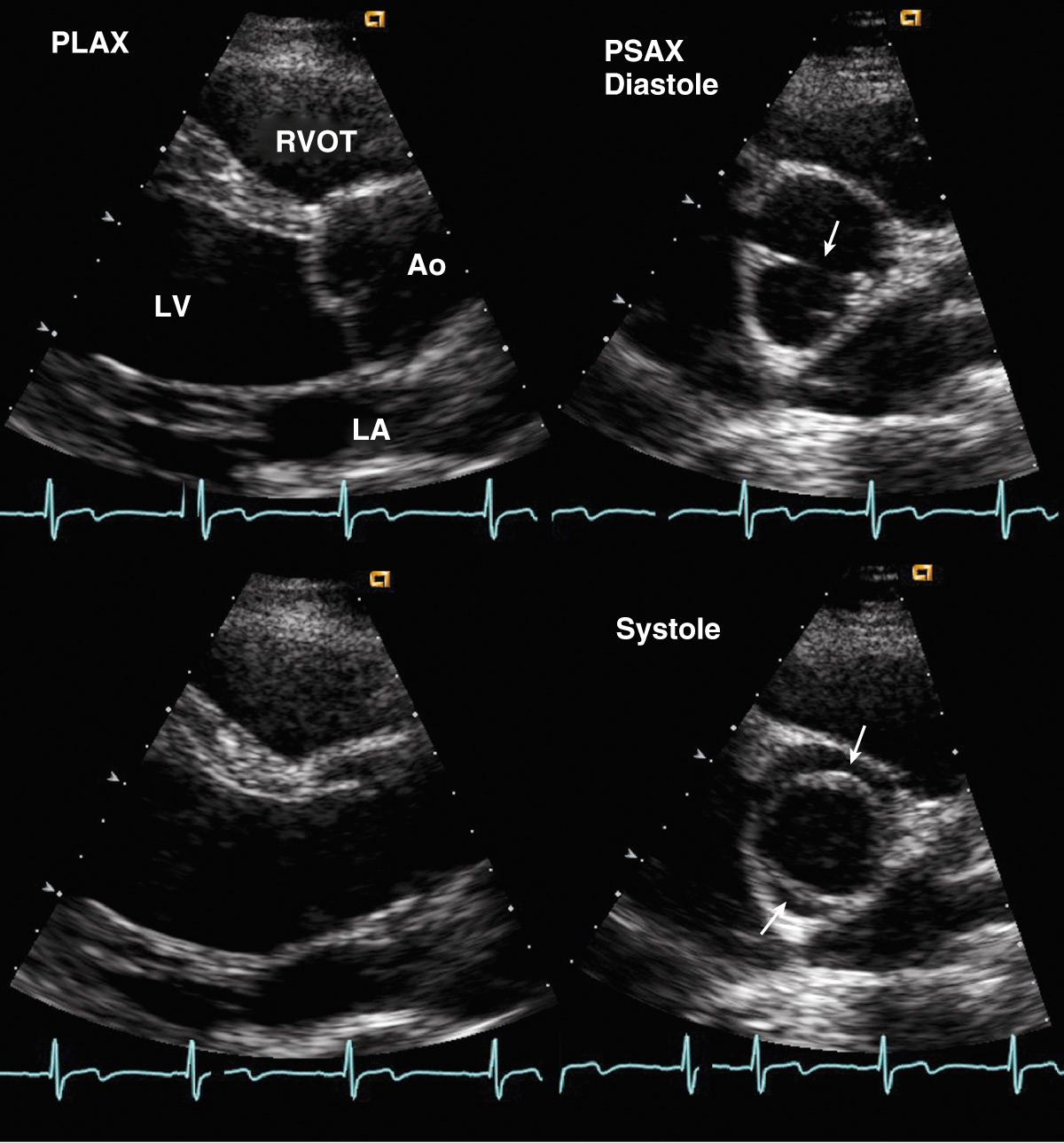
The most common bicuspid valve phenotype (seen in 70% to 80% of patients) is a larger anterior leaflet with the valve opening along an anterolateral-posteromedial closure line due to congenital fusion of the right and left coronary cusps ( Fig. 11.8 ). A larger rightward leaflet with the closure line running anteriorly to posteriorly due to congenital fusion of the right and noncoronary cusps accounts for about 20% to 30% of cases . Fusion of the noncoronary and left coronary cusps, with a medial-lateral closure line, is least common. Many bicuspid valves have a raphe in the larger leaflet, so the closed valve in diastole appears trileaflet; accurate identification of the number of aortic valve leaflets can be made only in systole. Doppler interrogation of the aortic valve should be performed whenever a bicuspid valve is suspected to evaluate for stenosis, regurgitation, or both. Bicuspid aortic valve disease often is associated with dilation of the aortic sinuses and ascending aorta, with the pattern and severity of aortic dilation related to valve morphology.
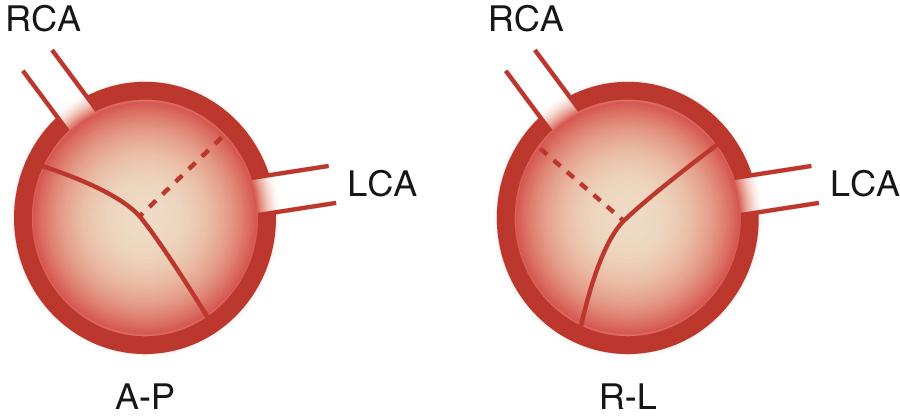
In about 30% of patients with mitral stenosis, rheumatic disease also affects the aortic valve. 2D and 3D imaging shows increased echogenicity along the leaflet edges, commissural fusion, and systolic doming of the aortic leaflets. Often, superimposed calcific changes make recognition of rheumatic aortic valve disease challenging. Rheumatic valvular disease preferentially involves the mitral valve, so a rheumatic cause is likely when aortic disease occurs concurrently with typical rheumatic mitral valve changes.
Congenital aortic stenosis usually is diagnosed in childhood, but some patients may not become symptomatic until young adulthood or may have restenosis after surgical valvotomy performed in childhood or adolescence. These patients most often have a unicuspid valve with a single eccentric orifice and prominent systolic doming.
The differential diagnosis of LV outflow obstruction includes:
Fixed subvalvular obstruction (a subaortic membrane or a muscular subaortic stenosis)
Dynamic subaortic obstruction (hypertrophic cardiomyopathy)
Supravalvular stenosis
In a patient with a clinical diagnosis of valvular aortic stenosis, the echocardiographic study should demonstrate whether the obstruction is, in fact, valvular or whether one of these other diagnoses accounts for the clinical presentation ( Fig. 11.9 ).
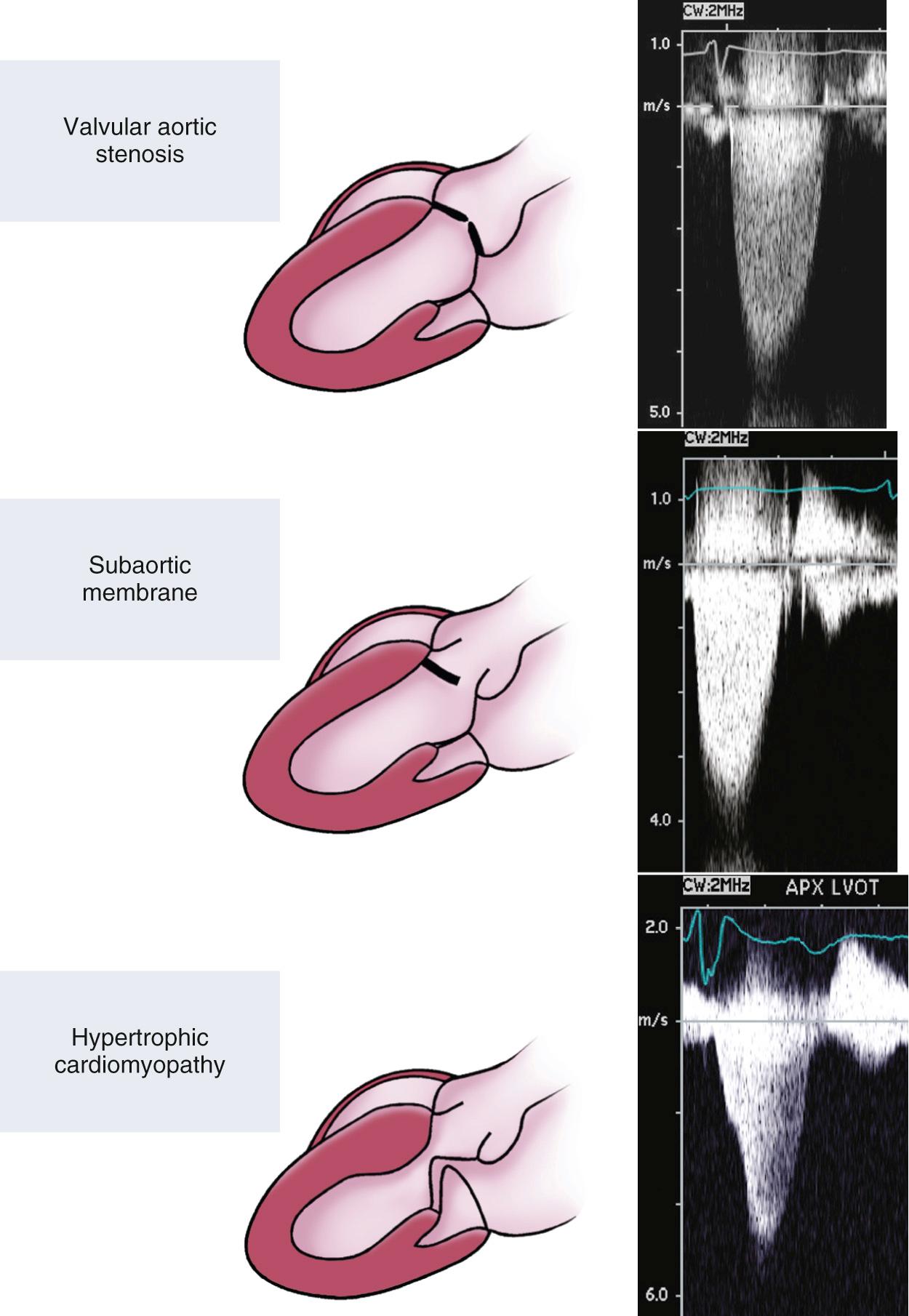
A subaortic membrane should be suspected in young adults when the valve anatomy is not clearly stenotic yet Doppler examination reveals a high transaortic pressure gradient. Because the membrane may be poorly depicted on a TTE study, TEE imaging should be considered when this diagnosis is suspected (see Fig. 17.1 ). The spatial orientation of the jet and the shape of the continuous-wave (CW) Doppler velocity curve are similar for fixed obstructions, whether subvalvular, supravalvular, or valvular, but careful pulsed Doppler or color flow imaging allows localization of the level of obstruction by detection of the poststenotic flow disturbance and site of increase in flow velocity.
In dynamic outflow obstruction, the timing and shape of the late-peaking CW Doppler velocity curve are distinctive. In addition, the degree of obstruction changes dramatically with provocative maneuvers, as detailed in Chapter 9 . In the occasional patient with both subvalvular and valvular obstruction, high-pulse repetition frequency Doppler ultrasound can be helpful in defining the maximum velocities at each site of obstruction.
The severity of valvular aortic stenosis can be determined accurately using equations derived from our understanding of the fluid dynamics of a stenotic valve. Standard evaluation of stenosis severity includes:
Maximum aortic jet velocity
Mean transaortic pressure gradient
Continuity equation valve area
Transvalvular velocity is the key measure in the evaluation of a patient with aortic valve stenosis. Aortic jet velocity alone is the strongest predictor of clinical outcome, the most reliable and reproducible measure for serial follow-up studies, and a key element in decision making about the timing of valve replacement. Because of the high velocities seen in aortic stenosis (usually 3 to 6 m/s), CW Doppler ultrasound is needed for optimal recording of the aortic jet signal. Examination should include use of a nonimaging, dedicated CW Doppler transducer because the smaller “footprint” of the dedicated transducer allows optimal positioning and angulation of the ultrasound beam, and signal-to-noise ratio is higher compared with a combined imaging and Doppler transducer.
Accurate measurement of aortic velocity requires a parallel intercept angle between the direction of the jet and the ultrasound beam. With a parallel alignment, cosine θ equals 1 and thus can be ignored in the Doppler equation (see Chapter 1 ). However, any deviation from a parallel intercept angle results in an underestimation of jet velocity. Although intercept angles within 15° of parallel will result in an error in velocity of 5% or less, an intercept angle of 30° will result in a measured velocity of 4.3 m/s when the actual velocity is 5 m/s. Underestimation of velocity, which is squared in the Bernoulli equation, results in an even larger error in calculated pressure gradient.
The direction of the aortic jet often is eccentric relative to both the plane of the aortic valve and the long axis of the aorta and rarely can be predicted from images of valve anatomy or by color flow Doppler imaging. Pragmatically, the solution to the problem of aligning the ultrasound beam parallel to an aortic jet of unknown direction is to perform a careful search from several acoustic windows with optimal patient positioning and multiple transducer angulations. The highest-velocity signal obtained then is assumed to represent the most parallel intercept angle. At a minimum, the aortic jet should be interrogated from an apical approach with the patient in a steep left lateral decubitus position on an examination bed with an apical cutout, from a high right parasternal position with the patient in a right lateral decubitus position, and from the suprasternal notch with the patient supine and the neck extended. In some cases, the highest-velocity signal may be recorded from a subcostal or left parasternal window. Even with a careful examination, the possibility of underestimation of jet velocity because of a nonparallel intercept angle should always be considered.
When the CW beam is aligned with the aortic jet, a smooth velocity curve is seen with a well-defined peak velocity and spectral darkening along the outer edge of the velocity curve. Audibly, the signal is high frequency and tonal. The spectral recording should be made with an appropriate velocity scale (about 1 m/s higher than the observed maximum jet velocity), wall filters set at a high level, and gain adjustment to provide clear definition of the peak signal. Maximum velocity is measured at the edge of the dark spectral envelope. The velocity-time integral is measured by digitizing the velocity curve over systole.
Care is needed to identify the origin of the high-velocity jet correctly. Other high-velocity systolic jets ( Table 11.1 and Fig. 11.10 ) may be mistaken for aortic stenosis if inadequate attention is paid to timing, shape, and associated diastolic flow curves. In some cases, 2D-“guided” CW Doppler may be helpful in the correct identification of the jet, followed by recording with a nonimaging transducer for optimal signal quality.
| Subaortic obstruction (fixed or dynamic) |
| Mitral regurgitation |
| Tricuspid regurgitation |
| Ventricular septal defect |
| Pulmonic or branch pulmonary artery stenosis |
| Peripheral vascular stenosis (e.g., subclavian artery) |
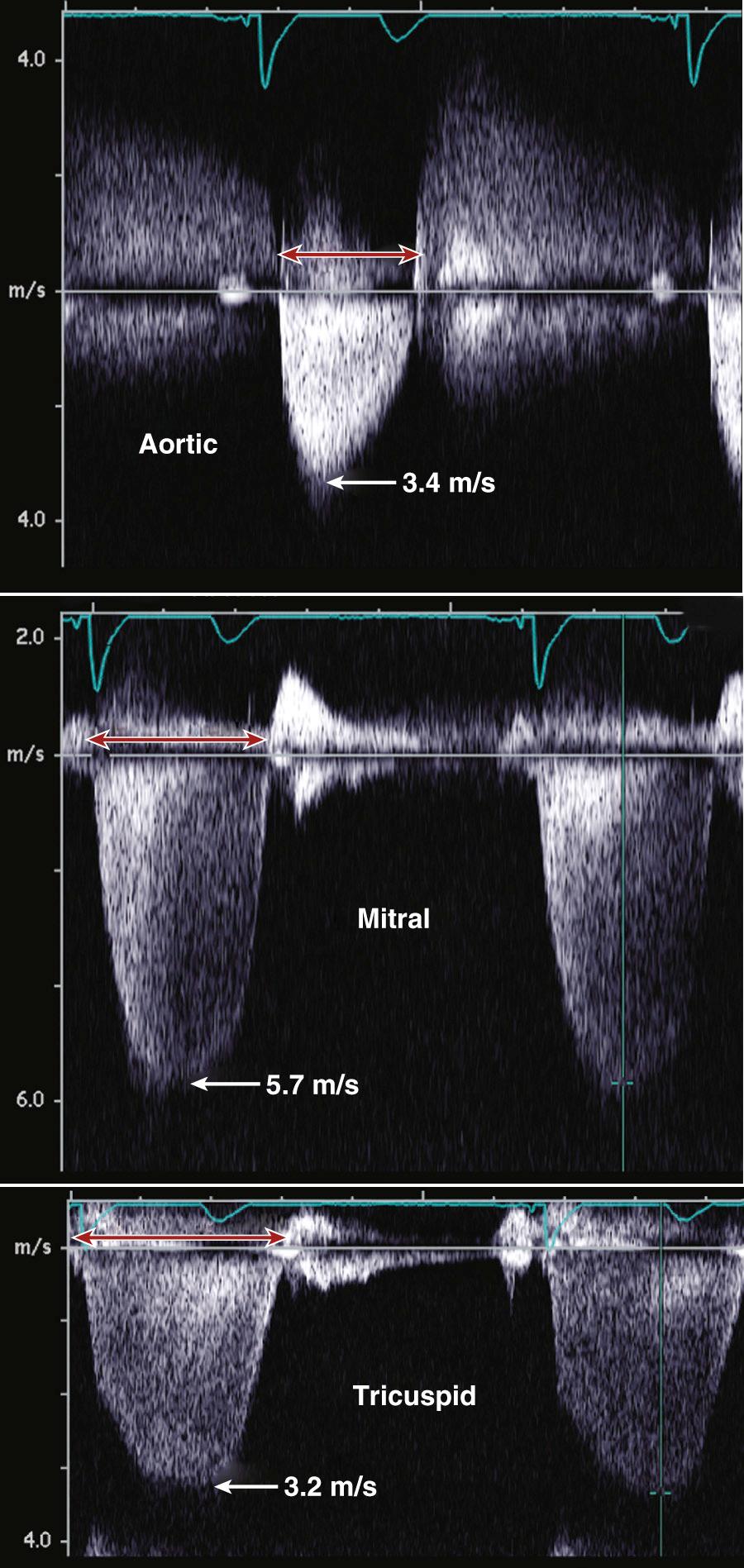
Maximum transaortic pressure gradient (Δ P max ) can be calculated from the maximum aortic jet velocity ( V max ) by using the simplified Bernoulli equation:
Mean pressure gradient (Δ P mean ) can be calculated by digitally tracing the aortic jet velocity curve (where v 1 ,…, v n , are instantaneous velocities) and then averaging the instantaneous gradients over the systolic ejection period:
With native aortic valve stenosis, the transaortic pressure gradient correlates closely and linearly with the maximum transaortic gradient, so the mean gradient can be approximated from published regression equations as:
With careful attention to technical details, Doppler-determined pressure gradients are accurate, as has been demonstrated in numerous in vitro and animal models and in clinical studies (see Appendix B , Table B.12 ). Although Doppler maximum gradients correspond to maximum instantaneous gradients by catheter measurement, and Doppler mean gradients correspond to catheter-measured mean gradients, neither Doppler gradient correlates with the peak-to-peak gradient reported at catheterization. In fact, peak aortic and peak LV pressures do not occur simultaneously, so none of the instantaneous velocities recorded with Doppler ultrasound are strictly comparable with this invasive measurement. Potential confusion about Doppler pressure gradient data in an individual patient can be avoided by comparing only mean gradients ( Fig. 11.11 ) or by simply recognizing that aortic velocity alone is the strongest predictor of clinical outcome.
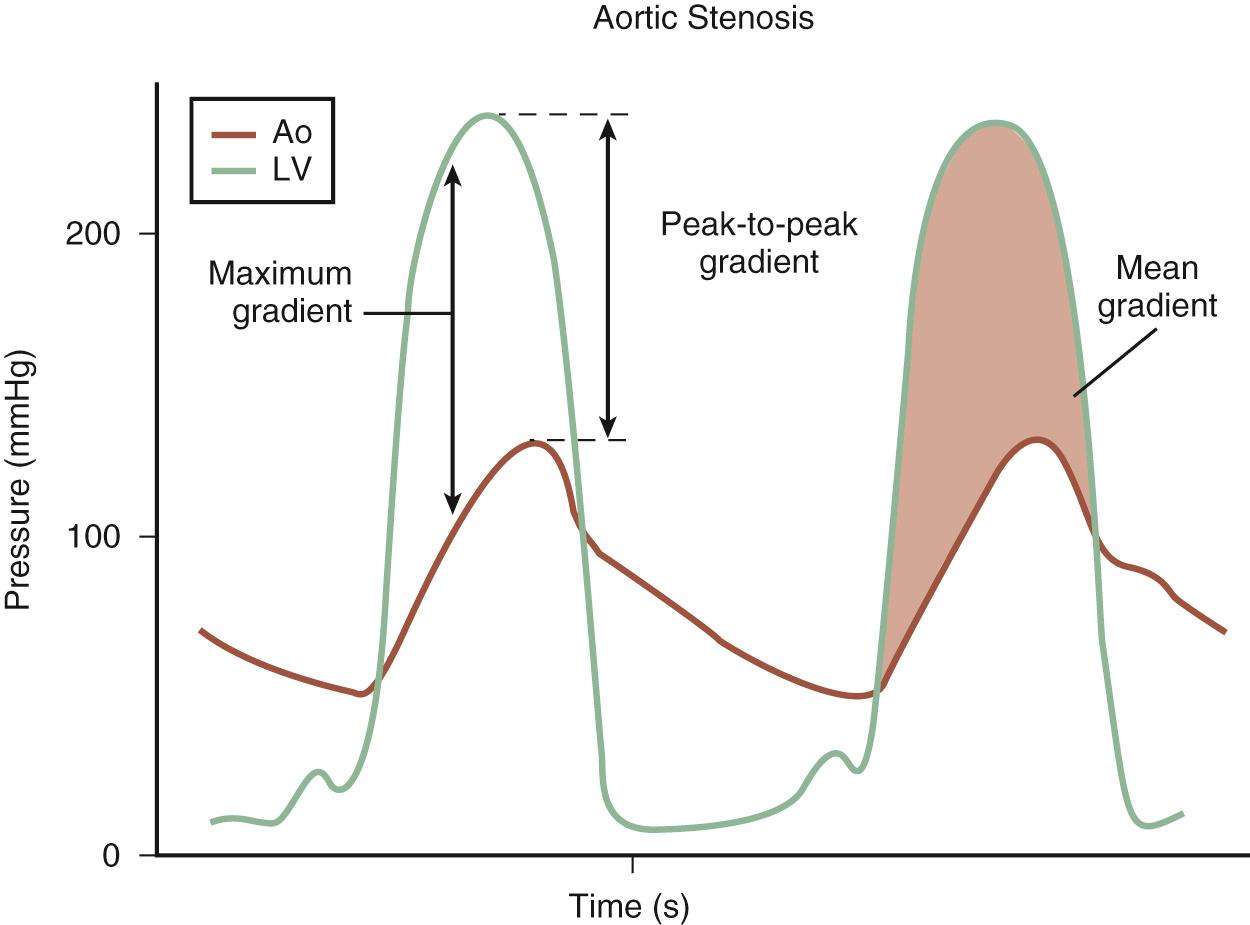
Physiologic changes in pressure gradient should be taken into consideration when comparing nonsimultaneous data recordings and inpatient management decisions. Pressure gradients depend on volume flow rate in addition to the degree of valve narrowing, so in an individual patient the pressure gradient rises when transaortic stroke volume increases (e.g., anxiety, exercise) and falls when stroke volume decreases (e.g., sedation, hypovolemia).
The dependence of pressure gradients on volume flow rate can lead to erroneous conclusions about stenosis severity in adult patients with either a chronically elevated or depressed transaortic stroke volume. For example, a patient with coexisting aortic regurgitation has a high transaortic pressure gradient with only a moderate degree of valve narrowing. Conversely, a patient with LV systolic dysfunction or coexisting mitral regurgitation may have a low transaortic pressure gradient despite severe aortic stenosis. These coexisting conditions are common in adults with valvular aortic stenosis, so determination of the stenotic orifice area is essential for complete evaluation of disease severity.
Aortic valve area can be calculated based on the principle of continuity of flow ( Fig. 11.12 ). Specifically, the stroke volume (SV) just proximal to the aortic valve in the LV outflow tract (SV LVOT ) and that in the stenotic aortic valve orifice (SV Ao ) are equal:
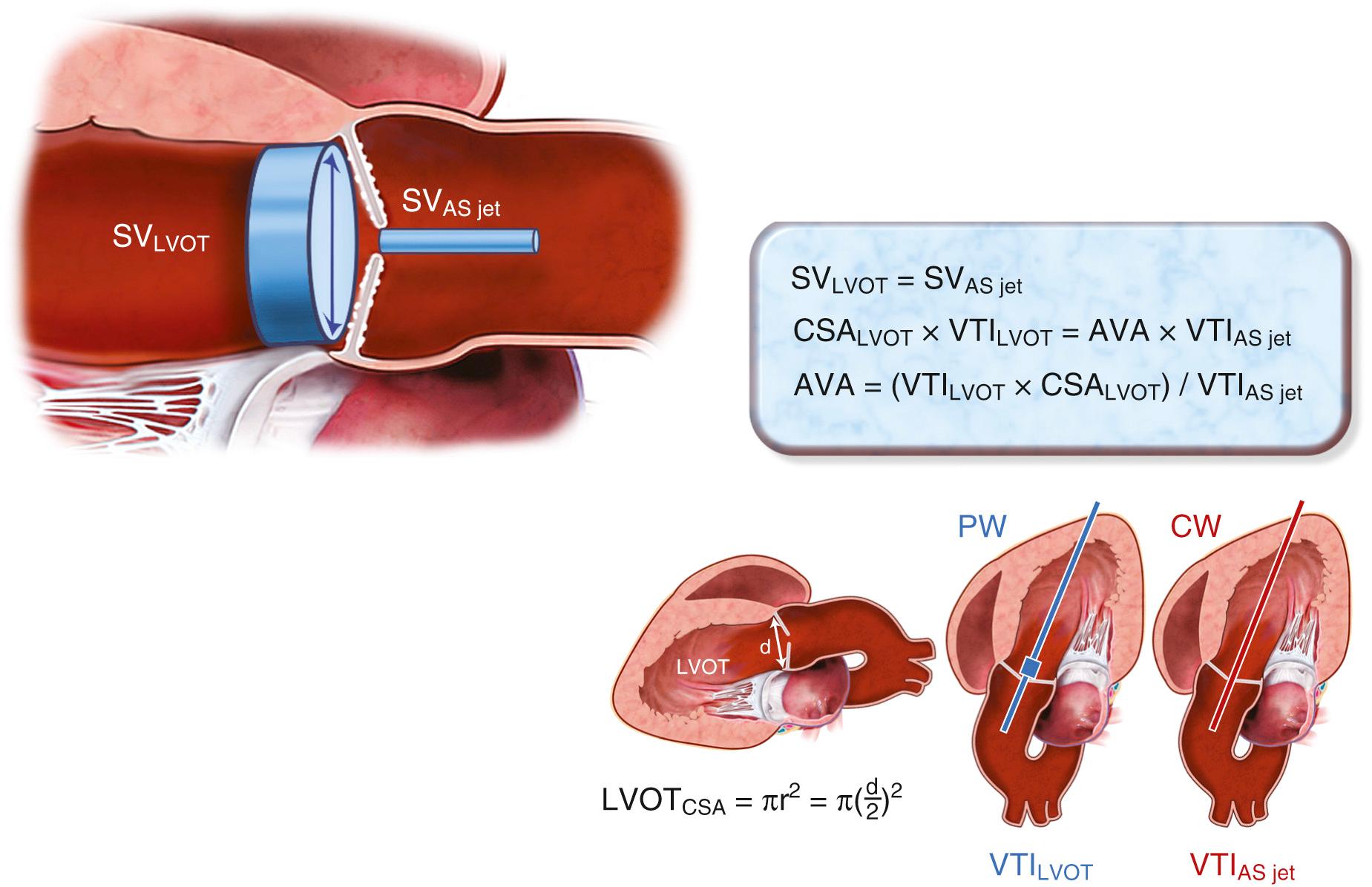
If flow is laminar with a spatially flat velocity profile,
where CSA is the cross-sectional area of flow (cm 2 ), SV is stroke volume (cm 3 ), and VTI is the velocity-time integral (cm). Because flow both proximal to and in the aortic jet itself is laminar with a reasonably flat velocity profile,
All the variables in this equation can be measured with 2D or Doppler echo except CSA Ao , which is the stenotic aortic valve area (AVA) itself. Rearranging the equation,
Thus, the measurements needed to calculate valve area with the continuity equation ( Fig. 11.13 ) are as follows:
LV outflow tract (or aortic annulus) diameter
LV outflow tract VTI
Aortic jet VTI
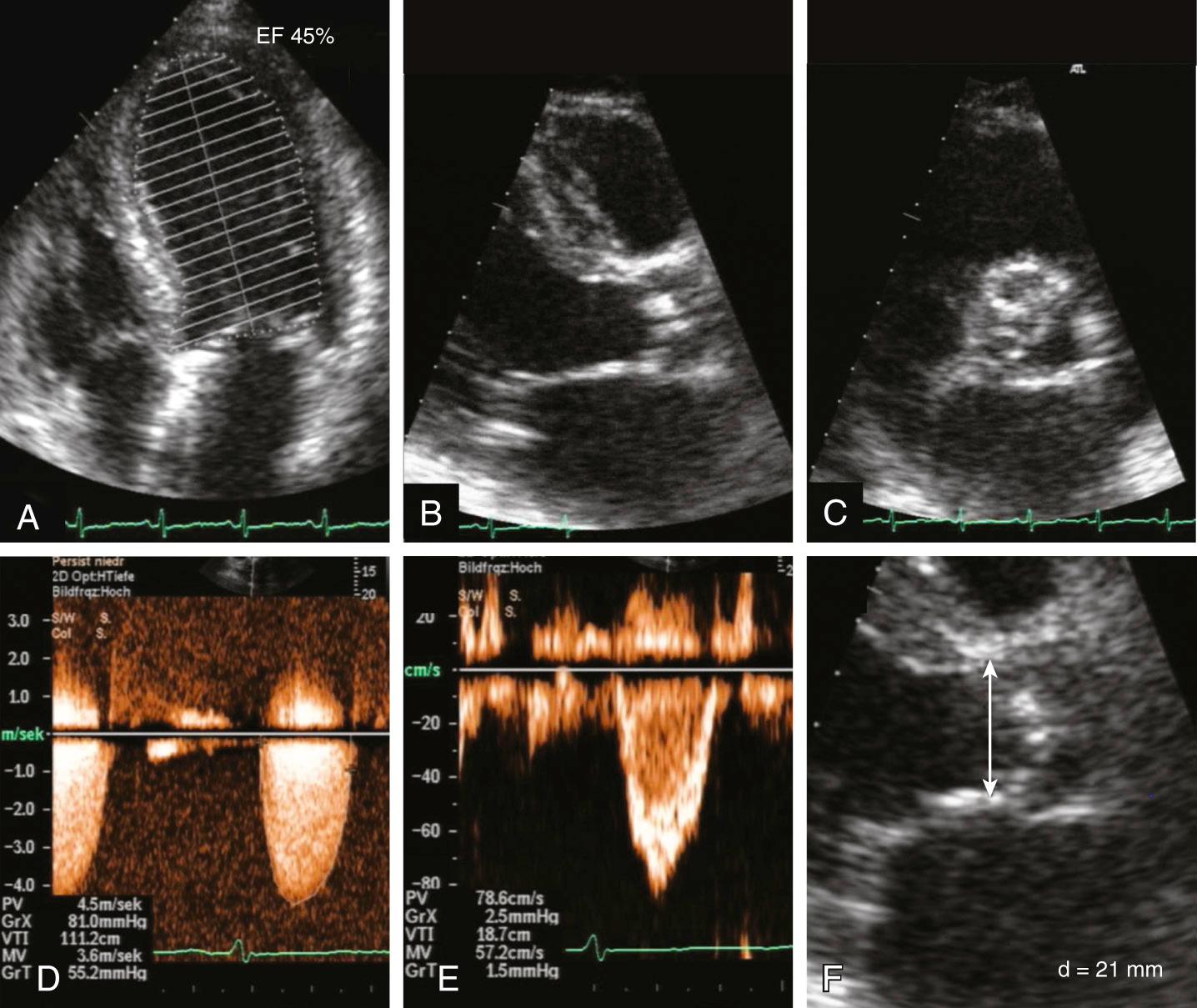
LV outflow tract diameter, measured on a 2D parasternal long-axis mid-systolic image, is used to calculate a circular outflow tract cross-sectional area (CSA). The velocity-time integral in the outflow tract is recorded with pulsed Doppler from an apical approach. The velocity-time integral in the aortic stenosis jet is recorded with CW Doppler ultrasound from the window that yields the highest velocity signal.
For clinical use, the continuity equation can be simplified by substituting maximum velocities (V) for velocity-time integrals. Because the shape and timing of outflow tract and aortic jet velocity curves are similar, their ratios are nearly identical:
The simplified continuity equation, then, is:
Continuity equation valve areas have been well validated in comparison with Gorlin formula valve areas calculated from invasive measurements of pressure gradient and cardiac output (see Appendix B , Table B.13 ). Some of the discrepancies between Doppler echo and invasive measurements of valve area are due to measurement variability for the invasive data and to limitations of the Gorlin formula itself. However, technical considerations in recording the Doppler and 2D echo data and the measurement variability of the noninvasive technique also are important ( Tables 11.2 and 11.3 ). Each laboratory should confirm the accuracy of its data by comparison with those of an experienced echocardiography laboratory or with other diagnostic tests.
| Technical |
| Acoustic access |
| Intercept angle between aortic stenosis jet and ultrasound beam |
| Outflow tract diameter imaging |
| Respiratory motion |
| Learning-curve effect |
| Interpretation |
| Identification of flow signal origin (AS vs. MR) |
| Beat-to-beat variability (AF, PVCs) |
| Intraobserver and interobserver measurement variability |
| Calculation errors |
| Physiology |
| Interim changes in heart rate or stroke volume |
| Dependence of velocity and Δ P on volume flow rate |
| Progression of AS severity |
| Low Flow Low Gradient AS |
| When EF <50%, assess changes in velocity and valve area with increased flow rates |
| When EF normal, index AVA to body size, calculated stroke volume index, consider other measures |
| Severe AS by Velocity or Gradient But Not by Valve Area (AS Velocity >4 m/s and AVA >1.0 cm 2 ) |
| LVOT diameter overestimated |
| LVOT velocity recorded too close to valve |
|
| Severe AS by Valve Area But Not by Velocity or Gradient (AS Velocity ≤4 m/s and AVA ≤1.0 cm 2 ) |
| LVOT diameter underestimated |
| LVOT velocity recorded too far from valve |
| Small body size |
|
LV outflow tract diameter is measured in mid-systole, immediately adjacent to the aortic valve leaflets, from the white-black interface of the septal endocardial echo to the white-black interface at the base of the anterior mitral leaflet. A parasternal long-axis view provides the most accurate measurement because it depends on the axial (rather than lateral) resolution of the ultrasound beam. For calculation of aortic valve area, outflow tract cross-sectional area (CSA) is assumed to be circular so that:
Note that small errors in outflow tract diameter measurement may lead to large errors in calculated cross-sectional area. Furthermore, of the measurements made for evaluating aortic stenosis severity, outflow tract diameter shows the greatest intraobserver and interobserver variability. Several measurements should be averaged to minimize this potential source of error.
Outflow tract diameter must be measured in each patient for accurate valve area calculations. Although women tend to have smaller outflow tracts than men and outflow diameter correlates to body size when people of all ages from infancy to adulthood are considered, in the adult population the relationship between sex or body size (either body surface area, height, or weight) and outflow tract diameter is weak. Conversely, outflow tract diameter tends to remain constant in a given adult patient over time. Apparent differences in diameter at follow-up visits are more likely to represent measurement error than an actual interval anatomic change.
Recent 3D imaging approaches show that the LV outflow tract is not exactly circular, so outflow tract diameter or aortic annulus measurements is not used for determining the correct transcatheter prosthetic valve size; 3D analysis of multidetector cardiac computed tomographic images is recommended for sizing of transcatheter valves. However, a circular assumption remains reasonable for valve area calculations used in clinical decision making.
Become a Clinical Tree membership for Full access and enjoy Unlimited articles
If you are a member. Log in here